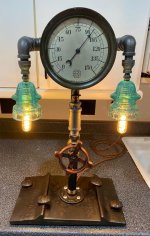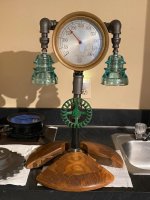So the two gauges I put photos above are rather special to me not just because my whole life I have always loved trains but for the good friend that I got them from.
I found them in a pile of stuff that a good friend of mine and legend in the local steam community here in Connecticut Bob Carlson left behind. I am not sure if anyone on this site is familiar with Bob but he was a great guy and the last guy I know who worked on steam locomotives when they were in operation. Apparently I think the CPRR was still running steam in Maine right up until about 1960 and Bob went up there and fired on the railroad until steam was on its way out. If there was a steam locomotive in the Northeast United States chances are you would see Bob around it and many of them he worked on. Bob had so many stories about the last days of steam. If anyone has read the book Farewell to Steam apparently there was a publication back in the day (I forget which one) that tracked all the fading steam in this country. Bob was reading that at the same time as Robert Ziel and a lot of those places that Ziel went Bob went too. Now if only I had Joe Michals memory and could write down all his stories for every one to enjoy but that is another story.
Bob was a really talented boilermaker. For years after steam went out he was running a company that supplied replacement staybolts and boiler parts.Thru out the 1960's I think he was the importer/distributor of the Locomotive Superheater Company(ELESCO) of England (Note after steam left in the USA the Locomotive Superheater company in the UK was still making parts and supporting steam over there for another 10-15yrs and Bob was importing the parts to keep steam alive for all the museums here in the USA. If you want to read further on Bob. A lot of great stuff was written about Bob over here
Railway Preservation News • View topic - Robert (Bob) Carlson, RIP.
Bob and I became really great friends several years ago. Bob was getting up there in age and there weren't many steam locomotive projects going on to keep him busy so I invited him to come over to give me a hand building my live steam locomotive boiler. As a retired welder out of Electric Boat of 30years Bob was the perfect guy to teach me how to weld on a boiler. He would come over ever Saturday and Sunday and we would spend the entire day working together out there in the shop. It was great cheap welding lessons, all I had to do was pay for lunch and dinners and Bob was happy as could be. . I learned a lot from him and had the greatest of time during those years he helped me get my live steam locomotive up and running.
When Bob passed I was able to get these gauges from his estate. For a while half of Bob was sitting in the tender of the locomotive we built together (The other half of him was laid to rest with his parents) but this past June we took Bob out for one last ride on his beloved 113 steam locomotive which he and a few other guys restored out on little more than a siding in the midst of anthracite country PA. Bob had no kids, I think that locomotive was the closest thing he had to a child of his own. So I was really satisfied to arrange for him to make one last trip thru a boiler he had spent so many years restoring, It was a fitting end for a great friend.
As to the gauges, One of them still needs to go up on the wall. The picture is no good but it is 0-600psig dual gauge. It says "Red Hand-Train Line, White Hand-Reducing Line". What is odd is 600psig sounds really high for a locomotive! I thought the Baldwin 60000 at the Franklin Institute was one of the highest steam pressure locomotives at 350psig. Add some margin for hydro and maybe it would make sense to use a 600 not a 400psig gauge but 600 still seems really high for a locomotive. I know when the Diesels started coming in they started putting steam generators onto trains I wonder what pressures those went up to? Anyone have any thoughts on this one?
The second gauge is a little more self explanatory it is an Exhaust Steam Injector gauge from ELESCO. It wouldn't surprise me if it came from his days representing them back when importing from England.Then again Bob was all over. I recall him telling me a story steam was on its way out up in Canada and he and a bunch of his friends were working on a Heisler at a trolley museum here in Connecticut. I think they needed a steam generator or maybe it was a lubricator. Bob wrote to the sales department at the railroad and they bought the rights to salvage one off the scrap lines of locomotives. He gets up to Canada in the middle of the winter and it is freezing and the shop foreman sees the note and tells him there is no way they are going out there to get one. Walks him into the big store room and takes a freshly overhauled unit off the shelf.Tells him to take it as the RR will be scraping out the store rooms soon enough. The unit proves too big to fit in Bob's car so no problem he writes up a ticket and has the thing sent rail freight to a station near Bob's house. Bob said he regretted not buying every bell whistle and everything in the place for most of his life.
Anyhow so that was a story of some of the gauges there.Anyone else collect stuff that remind them of great friends gone by?










![20211012_204547[1].jpg 20211012_204547[1].jpg](https://www.practicalmachinist.com/forum/data/attachments/276/276055-a14a6f9523ffbed3c0bff78a600a2365.jpg)
![20211012_221813[1].jpg 20211012_221813[1].jpg](https://www.practicalmachinist.com/forum/data/attachments/276/276056-08e66a0fa087c3262cb7afde86a0aa2e.jpg)


